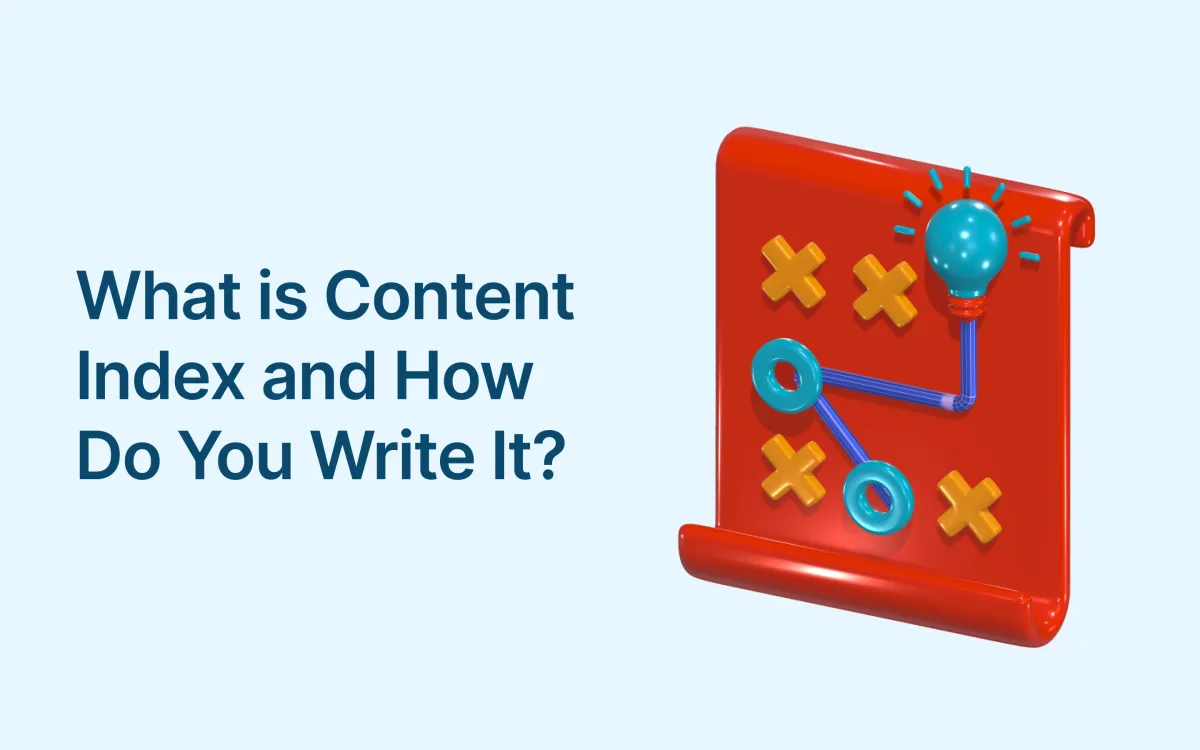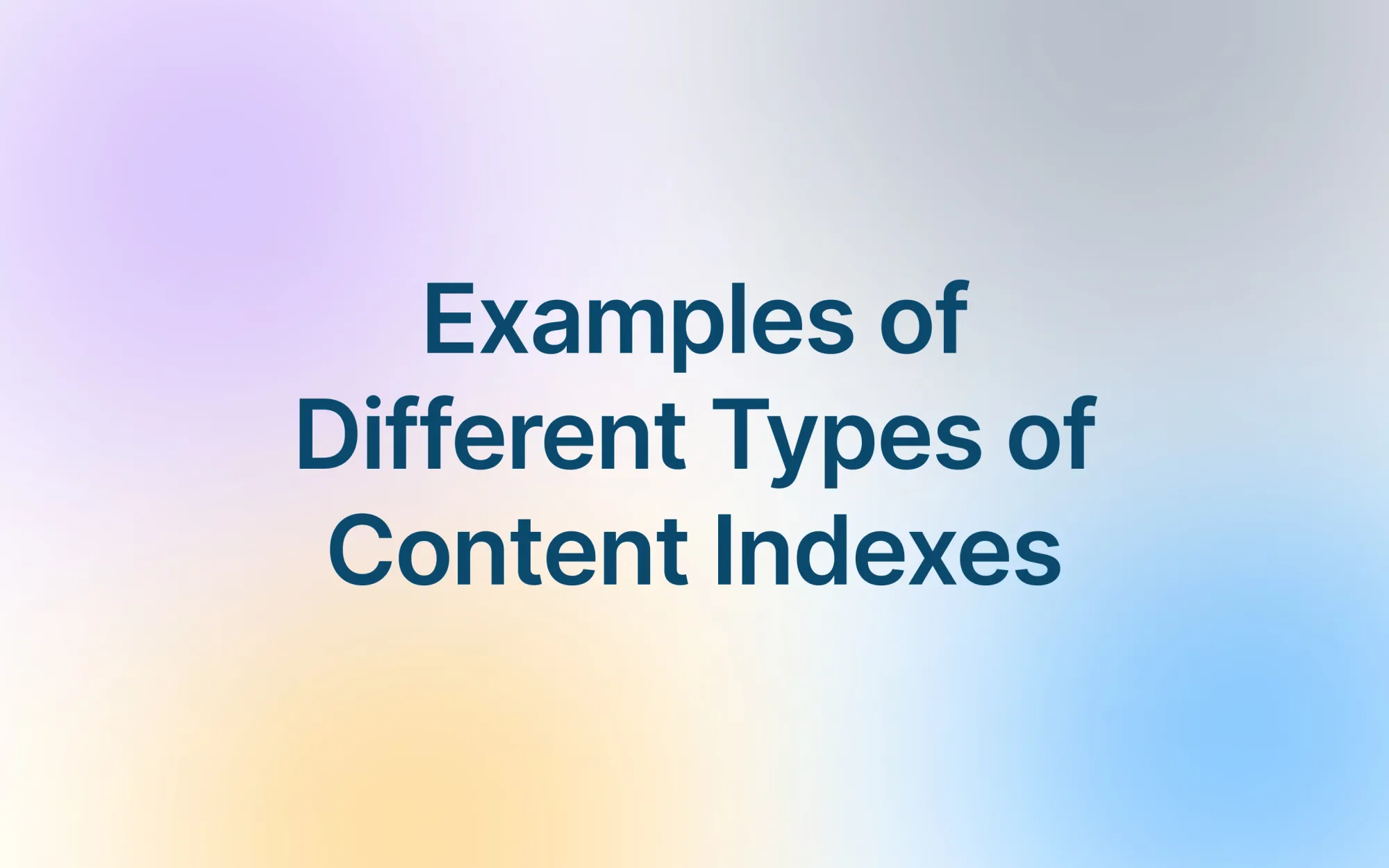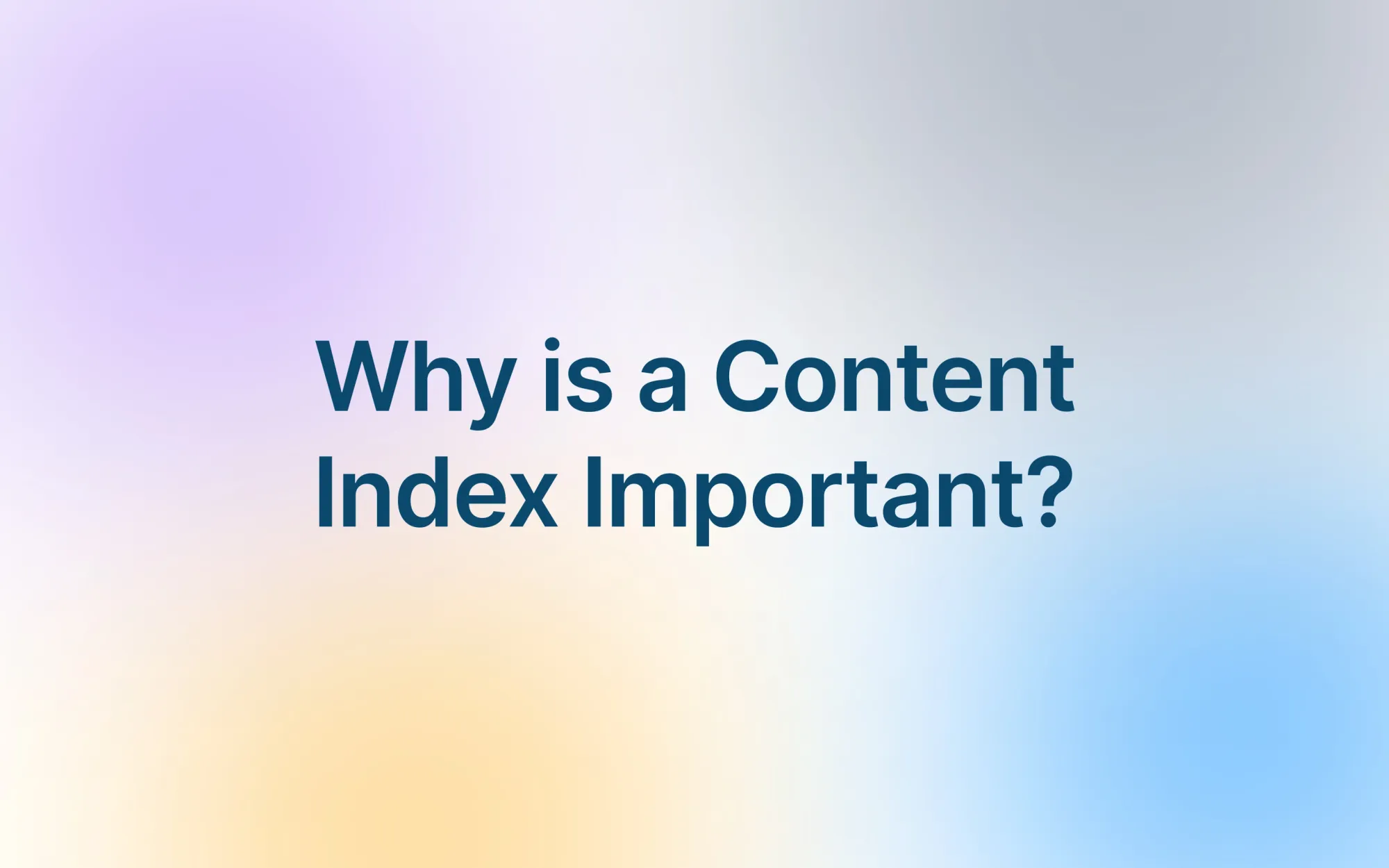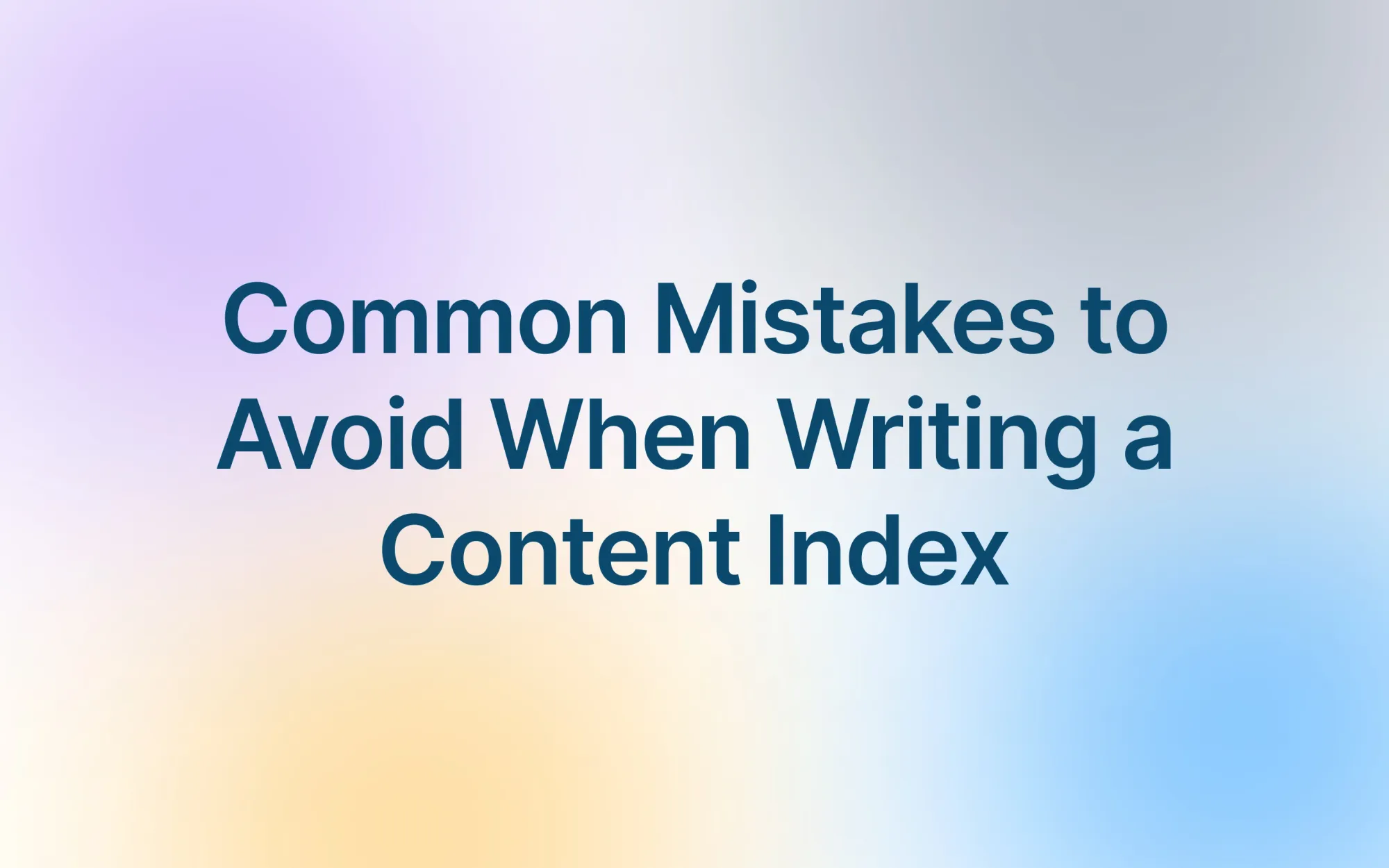What is Content Index and How Do You Write It?
Learn what a content index is, its importance for website organization, and discover best practices for creating an effective content index.

Have you ever opened a book or a long article and wished there was a quick way to find the information you were looking for?
That’s where a content index comes in. A content index is like a guide that shows you what topics are covered and where you can find them. It’s similar to a table of contents but can be used in many different types of writing, from blogs to research papers.
A well-organized content index keeps your information clear and easy to follow. Instead of leaving your readers to sift through everything, a content index makes sure they can quickly find the sections that matter most to them.
Whether you're creating a blog post, an e-book, or a research paper, having a content index makes your writing more structured, readable, and user-friendly.
What is a Content Index?
A content index is a simple list that shows the main ideas or sections within a piece of writing. It’s a way of organizing your content so readers can easily see what’s included and where to find specific information. Think of it as a roadmap that helps guide readers through your work, showing them the key points or topics before they dive in.
Role of Content Indexes in Writing and Research

Content indexes play an important role in writing and research by making information easier to access. When you have a lot of content, like a book or a long blog post, it can be hard for readers to find exactly what they need.
A content index gives them a clear overview, allowing them to skip to the parts they’re most interested in without having to read through everything. It helps save time and makes the experience more enjoyable for the reader.
In research, content indexes are even more crucial. Researchers often need to find very specific pieces of information. With a well-organized content index, they can quickly locate the sections that relate to their topic, speeding up their work and making the research process smoother.
Examples of Different Types of Content Indexes

There are many types of content indexes, depending on the kind of material you’re working with. For example:
- Books: Most books, especially nonfiction, have a table of contents at the front that lists all the chapters or main sections.
- Blogs: For longer blog posts or series, a content index can list the different sections or topics covered, helping readers jump to the parts that interest them.
- Research Papers: Academic papers often include an index or table of contents, especially if they are lengthy, to guide readers through the key sections like methodology, results, and discussion.
No matter what type of content you're working with, a content index is a simple yet powerful tool to improve structure and readability.
Why is a Content Index Important?

A content index is important because it helps make your writing clear, organized, and easy to follow. Whether you're creating a blog, a book, or any other type of content, having a content index provides several benefits.
1. Provides Structure and Organization
Think of a content index like the backbone of your writing. It helps you lay out your ideas in a logical order, so everything flows smoothly. Instead of having random information scattered around, a content index lets you organize your content in sections.
This makes it easier for readers to follow along and understand your message. Without a clear structure, your writing can feel confusing or overwhelming, but a good content index keeps things on track.
2. Enhances Readability and User Experience
When readers can quickly find what they’re looking for, it makes their experience much more enjoyable. A content index gives readers a map of your content, so they don’t have to scroll through everything to find the section they need. It also makes long pieces of content less intimidating because readers can easily skip to the parts that interest them. Overall, this boosts readability and ensures that people don’t get frustrated or lost while trying to navigate your content.
3. Benefits for SEO and Digital Content
If you're writing for the web, a content index can also help with search engine optimization (SEO). When you use a content index, it usually includes keywords and phrases that help search engines understand what your content is about.
This can improve your rankings on Google and other search engines, making your content more visible. In addition, a well-organized index can lead to a better user experience, which means people are more likely to stay on your page longer. This sends positive signals to search engines, further improving your site's SEO performance.
Steps to Write a Content Index

Creating a content index may seem like a big task, but by following these simple steps, you can easily build one that is clear and helpful for your readers. Here's how:
Step 1: Understand the Purpose of Your Content
Before you start creating your content index, it’s important to know why you’re writing the content and who it’s for. Ask yourself:
- What is the goal of this document? (e.g., to inform, to educate, to entertain?)
- Who is my target audience? (e.g., students, professionals, customers?)
Understanding this helps you choose the right information to include in the index and ensures that it’s useful for your readers.
Step 2: Identify Key Concepts
Next, you’ll want to pinpoint the main ideas or themes in your content. These are the key concepts that your readers will want to find quickly. Go through your content and ask yourself:
- What are the most important points or sections?
- What ideas or topics are repeated or emphasized?
Once you have the key concepts, categorize them into main themes and subthemes. This will help you group similar ideas together, making the content easier to navigate.
Step 3: Organize Concepts Logically
Now, it’s time to arrange your key concepts in a way that makes sense. Think about how your readers would want to move through your content. For example:
- Start with the big ideas or general sections first, then break them down into smaller subtopics.
- Use headings and subheadings to separate different sections.
This logical structure improves the readability of your content and ensures that your readers can easily find the information they’re looking for.
Step 4: Use Clear and Descriptive Titles
When writing your content index, make sure the titles for each section are clear and descriptive. Readers should understand what the section is about just by looking at the title. For example:
- Instead of "Chapter 1," use "Chapter 1: How to Create a Content Index."
Also, if you're writing for online content, don’t forget to include keywords in your titles. This not only helps your readers but also improves your SEO (search engine optimization), making it easier for people to find your content online.
Step 5: Maintain Consistency
Lastly, make sure your format, style, and organization are consistent throughout the entire index. This means:
- Use the same font, size, and layout for all your headings and subheadings.
- Stick to a clear structure (e.g., all main sections are bolded, subtopics are italicized).
Consistency helps your content look professional and polished, making it easier for readers to follow along without confusion.
By following these steps, you can create a content index that is well-organized, reader-friendly, and enhances the overall quality of your writing.
Best Practices for Writing a Content Index

Writing a good content index involves more than just listing topics—it’s about making sure the index is easy to use and helps readers find what they’re looking for quickly. Here are some best practices to keep in mind:
1. How to Choose the Right Keywords and Phrases
When writing a content index, it's important to use the right words so readers and search engines can understand what each section is about. Here’s how to choose the best keywords:
- Think about your audience: What words or phrases are they likely to search for? For example, if you're writing about dog training, phrases like “dog training tips” or “puppy obedience” might be important.
- Use relevant keywords: These are words directly related to the main topics in your content. Avoid using overly technical or confusing terms that your audience might not understand.
- Focus on clarity: Choose words that are simple and easy to understand. The goal is to help your readers find exactly what they need without guessing what a section is about.
2. Making the Index Easy to Navigate for the Reader
A great content index is one that’s user-friendly and simple to navigate. Here’s how to make that happen:
- Keep it organized: Arrange your topics in a logical order. For example, start with broader subjects and break them down into smaller sections or subtopics.
- Use headings and subheadings: This helps break up the content into digestible sections. For example, if you’re writing about gardening, the main heading could be “Plant Care” with subheadings like “Watering” and “Pruning.”
- Include page numbers or links: In print, page numbers are essential for guiding readers to the right spot. For online content, you can include clickable links so readers can jump straight to the section they want.
3. Tips for Revising and Updating Content Indexes
A content index should evolve with your content, especially for online writing where things can change frequently. Here are a few tips for keeping it fresh:
- Review regularly: Set a schedule to review your content index, especially after major updates or changes to your content. This ensures that the index stays accurate and reflects any new sections or topics.
- Remove outdated sections: If some parts of your content are no longer relevant, update or remove those sections from the index. An outdated index can confuse readers and make your content feel less trustworthy.
- Simplify when necessary: Over time, an index can become cluttered. If you notice that your index is getting too long or complicated, simplify it by combining similar sections or trimming unnecessary details.
By following these best practices, you can create a content index that not only helps your readers but also keeps your content well-organized, up-to-date, and easy to navigate.
Common Mistakes to Avoid When Writing a Content Index

While creating a content index can greatly improve the readability and organization of your writing, there are a few mistakes that can reduce its effectiveness. Here are some common pitfalls to watch out for, and how to avoid them:
1. Overloading the Index with Irrelevant Information
One big mistake is cramming the content index with too much detail or unnecessary topics. This can overwhelm readers and make the index confusing. Here’s what to avoid:
- Too many subtopics: While it’s important to be thorough, adding every tiny detail to the index can clutter it. Stick to the main ideas or sections that are most important.
- Unrelated or off-topic sections: Only include topics that directly relate to your content. Irrelevant information distracts the reader and makes your index less useful.
Solution: Focus on including only the key points or major sections that will help readers understand your content at a glance. Keep it simple and concise.
2. Lack of Clarity in Headings and Subheadings
If your headings and subheadings are unclear, readers may struggle to understand what each section is about. This defeats the purpose of having a content index in the first place. Here's what to watch for:
- Vague titles: Avoid generic or unclear titles like “Section 1” or “Topic A.” These don’t tell the reader anything about what’s in that section.
- Overly complex language: Using fancy or technical terms might confuse readers, especially if they aren’t familiar with the topic.
Solution: Make sure your headings and subheadings are straightforward and descriptive. For example, instead of “Part 1,” use “Part 1: Basic Dog Training Tips.” This gives the reader a clear idea of what to expect.
3. Failing to Reflect the Structure of the Document
Another mistake is creating an index that doesn’t match the actual flow of your content. If the index doesn’t reflect the structure of the document, readers will find it difficult to navigate through the material. Here are some issues to avoid:
- Incorrect order of sections: If the index lists sections in a different order than they appear in the content, readers will get confused.
- Missing important sections: Skipping key sections or ideas can make the index incomplete, leaving readers lost.
Solution: Make sure your index accurately mirrors the structure of your content. Go through your document and organize the index in the same order, making sure all major sections are included.
By avoiding these common mistakes, you can create a clean, clear, and effective content index that enhances the reading experience and makes your content more accessible.
Conclusion
Creating a content index is a simple yet powerful way to make your writing more organized and reader-friendly. By carefully choosing the right keywords, keeping your index clear and easy to navigate, and avoiding common mistakes, you can help your readers find exactly what they need without any hassle.
Whether you’re writing a book, blog, an e-book, or a research paper, a well-crafted content index will guide your readers smoothly through your content and enhance their overall experience. Remember, a good content index isn’t just about listing topics—it’s about making your content more accessible, understandable, and enjoyable for everyone who reads it.
Frequently Asked Questions
1. What does content index mean?
A content index is a simple list that shows the main topics or sections in a piece of writing. It helps readers get an overview of what’s included and where to find specific information. You’ve probably seen a content index in books, where it’s called a “table of contents,” and it lists the chapters and page numbers. It acts as a guide to help you navigate the content more easily.
2. What is an index or content?
An index or content is a list of topics, ideas, or sections in a document, book, or piece of content. It’s a helpful tool for organizing information so readers can quickly find what they’re looking for. An index is usually at the back of a book, while a table of contents is at the front. Both serve a similar purpose: they guide readers to the specific parts of the material they’re interested in.
3. How do you write a content index?
To write a content index, follow these steps:
- Identify the key topics: Look through your content and pick out the main ideas or sections that readers would want to find quickly.
- Organize the ideas: Group similar topics together in a logical order, like moving from general to specific topics.
- Use clear titles: Make sure your headings and subheadings are easy to understand and describe what’s in each section.
- Add page numbers or links: If it’s a print document, include page numbers. If it’s online, include clickable links to help readers jump directly to each section.
4. What is content index definition in research?
In research, a content index is a tool used to organize and list the important sections of a paper, report, or study. It usually includes the major parts of the research, such as the introduction, methodology, results, and conclusion, with page numbers or links. This helps readers, especially other researchers, quickly find the specific parts of the study they need to read, making the research easier to understand and navigate.
5. What is content index page?
A content index page is a page in a document, book, or website that lists all the main sections or topics covered. It usually includes headings, subheadings, and sometimes page numbers or links to help readers easily find specific information. This page serves as a navigation tool, especially in longer documents or websites, giving a clear overview of the content at a glance.



